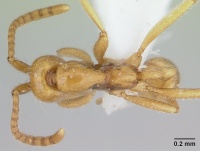Neivamyrmex humilis
| Neivamyrmex humilis | |
|---|---|

| |
| Scientific classification | |
| Kingdom: | Animalia |
| Phylum: | Arthropoda |
| Class: | Insecta |
| Order: | Hymenoptera |
| Family: | Formicidae |
| Subfamily: | Dorylinae |
| Genus: | Neivamyrmex |
| Species: | N. humilis |
| Binomial name | |
| Neivamyrmex humilis (Borgmeier, 1939) | |
This species is only known from queens and/or workers and has yet to be associated with males.
Identification
Jack Longino: Posterior face of propodeum straight, not concave, shorter than dorsal face; eye absent; katepisternum and side of propodeum largely smooth and shining; anteroventral margin of petiole lacking tooth.
Distribution
Latitudinal Distribution Pattern
Latitudinal Range: 13.7695434° to 3.406944444°.
| North Temperate |
North Subtropical |
Tropical | South Subtropical |
South Temperate |
- Source: AntMaps
Distribution based on Regional Taxon Lists
Neotropical Region: Costa Rica (type locality), Honduras, Venezuela.
Distribution based on AntMaps
Distribution based on AntWeb specimens
Check data from AntWeb
Countries Occupied
| Number of countries occupied by this species based on AntWiki Regional Taxon Lists. In general, fewer countries occupied indicates a narrower range, while more countries indicates a more widespread species. |

|
Estimated Abundance
| Relative abundance based on number of AntMaps records per species (this species within the purple bar). Fewer records (to the left) indicates a less abundant/encountered species while more records (to the right) indicates more abundant/encountered species. |

|
Biology
Jack Longino: One collection of this species was from Sirena in Corcovado National Park. This is a lowland rainforest site. At 0600hrs, a column was crossing a trail and entering a hole in the ground. The end of the column disappeared down the hole as I watched. A second collection was workers obtained in a Malaise trap sample at the 500m site (El Ceibo) on the Barva transect in Braulio Carrillo National Park. The type specimens were collected near San José in the early 1900's.
Castes
Nomenclature
The following information is derived from Barry Bolton's Online Catalogue of the Ants of the World.
- humilis. Eciton (Acamatus) humile Borgmeier, 1939: 415 (w.) COSTA RICA.
- Type-material: syntype workers (number not stated, “several”).
- Type-locality: Costa Rica: San José (H. Schmidt).
- Type-depositories: MCZC, MSNG, MZSP.
- Borgmeier, 1948a: 194 (q.m.).
- Combination in E. (Neivamyrmex): Borgmeier, 1948a: 194;
- combination in Neivamyrmex: Borgmeier, 1953: 5.
- Status as species: Borgmeier, 1948a: 194 (redescription); Borgmeier, 1955: 401 (redescription); Kempf, 1972a: 155; Watkins, 1976: 17 (in key); Bolton, 1995b: 289; Palacio, 1999: 158 (in key); Palacio, 2019: 621.
- Distribution: Colombia, Costa Rica, Honduras, Nicaragua, Panama, Venezuela.
Description
References
- Borgmeier, T. 1939. Nova contribuiça~o para o conhecimento das formigas neotropicas (Hym. Formicidae). Rev. Entomol. (Rio J.) 10: 403-428. (page 415, worker described)
- Borgmeier, T. 1948a. Die Geschlechtstiere zweier Eciton-Arten und einige andere Ameisen aus Mittel- und Suedamerika (Hym. Formicidae). Rev. Entomol. (Rio J.) 19: 191-206 (page 194, queen, male described)
- Borgmeier, T. 1948a. Die Geschlechtstiere zweier Eciton-Arten und einige andere Ameisen aus Mittel- und Suedamerika (Hym. Formicidae). Rev. Entomol. (Rio J.) 19: 191-206 (page 194, Combination in E. (Neivamyrmex))
- Borgmeier, T. 1953. Vorarbeiten zu einer Revision der neotropischen Wanderameisen. Stud. Entomol. 2: 1-51 (page 5, Combination in Neivamyrmex)
- Borgmeier, T. 1955. Die Wanderameisen der neotropischen Region. Stud. Entomol. 3: 1-720 (page 401, see also)
References based on Global Ant Biodiversity Informatics
- Basset Y., L. Cizek, P. Cuenoud, R. K. Didham, F. Guilhaumon, O. Missa, V. Novotny, F. Odegaards, T. Roslin, J. Schmidl et al. 2012. Arthropod diversity in a tropical forest. Science 338(6113): 1481-1484.
- Chacon de Ulloa P., A. M. Osorio-Garica, R. Achury, and C. Bermudez-Rivas. 2012. Hormigas (Hymenoptera: Formicidae) del Bosque seco tropical (Bs-T) de la cuenca alta del rio Cauca, Colombia. Biota Colombiana 13(2): 165-181.
- Fernández F., E. E. Palacio, W. P. Mackay, and E. S. MacKay. 1996. Introducción al estudio de las hormigas (Hymenoptera: Formicidae) de Colombia. Pp. 349-412 in: Andrade M. G., G. Amat García, and F. Fernández. (eds.) 1996. Insectos de Colombia. Estudios escogidos. Bogotá: Academia Colombiana de Ciencias Exactas, Físicas y Naturales, 541 pp
- Longino J. T. 2013. Ants of Nicargua. Consulted on 18 Jan 2013. https://sites.google.com/site/longinollama/reports/ants-of-nicaragua
- Longino J. T. L., and M. G. Branstetter. 2018. The truncated bell: an enigmatic but pervasive elevational diversity pattern in Middle American ants. Ecography 41: 1-12.
- O'Donnell S., J. Lattke, S. Powell, and M. Kaspari. 2007. Army ants in four forests: geographic variation in raid rates and species composition. Journal of Animal Ecology 76: 580-589.
- Palacio E. 1999. Hormigas legionarias (Hymenoptera: Formicidae: Ecitoninae) de Colombia. Pp. 117-189 in: Amat-G., G.; Andrade-C., M. G.; Fernández, F. (eds.) 1999. Insectos de Colombia. Volumen II. Bogotá: Academia Colombiana de Ciencias Exactas, Físicas y Naturales, 433 pp.
- Watkins J. F., II 1976. The identification and distribution of New World army ants (Dorylinae: Formicidae). Waco, Texas: Baylor University Press, 102 pp

